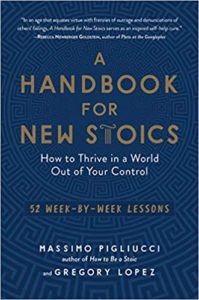
A Handbook for New Stoics
By Massimo Pigliucci and Gregory Lopez
336 pages
Published May 14, 2019, by The Experiment
I’ve read essays by Seneca, discourses by Epictetus, and Marcus Aurelius’s Meditations several times. I’ve written essays about how I’ve tried to incorporate Stoicism into various aspects of my life. But until I read this “handbook,” I didn’t appreciate the depth and range of the Stoic philosophy.
Stoicism has emerged as one of the defining philosophies of the new millennium. Not at the universities, which are neck deep in name-and-blame ideologies (Stoicism’s polar opposite), but among thought leaders in the digital self-improvement communities.
A core tenet of Stoicism – and the idea that is most commonly associated with it – is accepting the fact that there is much in the world over which we have little or no control. Rather than stress over those things, the Stoic deploys his attention on things he can change. The most significant of those things are his thoughts and feelings.
That was my core view of Stoicism, and it was more than enough for me. But it turns out that there is much more to it than this. A Handbook for New Stoics helped me understand that Stoicism is actually a moral philosophy. It is not just about how to live the least stressful and most productive life. It is also about developing a mindset that is just and can make just decisions.
What I Liked About It:
* It broadened my understanding of Stoicism.
* It was a quick study in some Stoic writings I had never read.
* The writing was readable.
* The ideas were easily accessible.
What I Didn’t Like:
Nothing that I can think of.
A few examples of what you will learn in this book:
* Why we must accept the nature of human nature
* Three things we must recognize as impermanent: life, possessions, and circumstances
* Why we should “let go of” the good as well as the bad
* The 3 core disciplines of Stoicism: Desire, Action, and Assent
* The 9 exercises you can do to achieve them
A Handbook for New Stoics is a guide to not just understanding but also practicing Stoicism. Which makes it well worth a read in today’s confusing political and social environment.
Critical Reception
* “In an age that equates virtue with frenzies of outrage and denunciations of others’ failings, A Handbook for New Stoics serves as an inspired self-help cure that, with insight and sympathy, will nudge you in the direction of the happiness and equanimity born of strength of character and wisdom.” (Rebecca Newberger Goldstein, author of Plato at the Googleplex)
* “A wonderfully simple approach to the core concepts and techniques of Stoicism…. Pigliucci and Lopez have managed to make Stoicism accessible to anyone.” (Donald Robertson, cognitive-behavioral psychotherapist and author of How to Think Like a Roman Emperor)
* “A wonderful and potentially life-altering way to encounter the wisdom of the Stoics.” (Professor William B. Irvine, author of A Guide to the Good Life)
* “A great hands-on introduction to Stoic philosophy and practice…. Well-researched and carefully structured.” (Gregory Sadler, editor of Stoicism Today)
 MarkFord
MarkFord